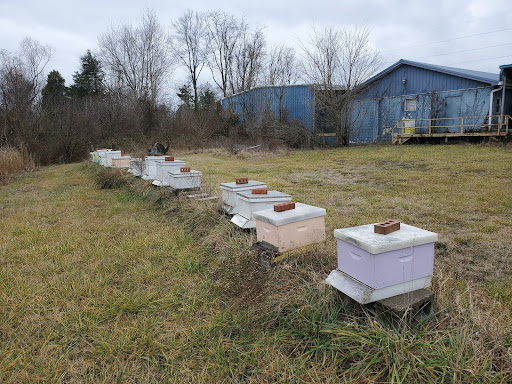During the North American Honey Bee Expo this January, staff scientist, David Peck, and Betterbee co-owner, John Rath, had a great time talking with Duane Davis, who runs the beekeeping supply store Dogwood Ridge Bees in Boonville, Indiana with his wife and business partner, Kimberly. While we were chatting, Duane shared his strategy to control swarming in his hives, and it was such a straightforward method (from a beekeeper who we really trust) that we decided to share it.

Kimberly and Duane Davis own and run Dogwood Bees
Swarming: To fight the bees, or not to fight the bees?
If you take Betterbee’s Focus on: Swarming and Splitting class you’ll learn that often, the easiest way to suppress a colony’s swarming instinct is just to give the bees what they want. When a colony swarms, their goal is to turn one colony into two colonies. By splitting a large and growing colony you can give the bees exactly what they wanted, without anyone flying off into the trees and away from your apiary. Duane’s method uses that same principle to prevent growing colonies from getting too big for their britches.
Duane’s method
His strategy for swarm control is both simple and effective. He waits until his overwintered colonies have gotten through winter and really started to grow their population. His swarm control begins about the day that the apple trees are in full bloom. This handy signal is useful anywhere that apple trees grow, because whether it happens in March, April, or May your bees and your apple trees are likely to be on roughly similar schedules.
When the apple trees are blooming, Duane goes through each colony and determines how big they are. A colony that covers five or six frames is left alone to keep growing, but any colonies with seven or more frames are knocked down to just five frames. By leaving a solid five frames of bees, brood, and resources in the hive Duane assures that they are strong enough to keep growing. By pulling off some excess bees and brood, Duane slows the colony down a bit so they don’t outgrow their hive and start thinking about swarming. These strong colonies are eager to create comb on the frames of foundation used to fill gaps where brood frames were removed.
What about the “extra” bees?
What to do with all those extra frames of bees and brood? Make splits, of course! All of the frames that Duane pulls from his overwintered colonies get mixed and matched to create splits with the right mix of bees, brood, pollen, and honey.
Duane likes to spray a mixture of sugar syrup and Honey-B-Healthy onto the frames that he removes from his colonies. Diluting 4 teaspoons of Honey-B-Healthy into about a quart of 1:1 sugar syrup helps to calm the bees, and the smell helps to disguise the fact that he’s mixing together frames from multiple different colonies. He uses the spare frames of bees and brood to make additional 5-frame colonies, and as soon as they’re finished he seals them up and moves them to a distant apiary, so that the bees don’t try to return to the hive they came from. These new 5-frame colonies get a newly purchased queen and start to grow.
It’s also fine to use frames of brood to boost the strength of weaker colonies, instead of making splits. This is called "equalizing."

A Dogwood Ridge apiary, behind their store at 6200 N. IN-61, Boonville, IN
Meanwhile, the original overwintered colonies are all knocked down a peg but will keep growing too. By the time the spring nectar flow of clover and autumn olive begins, all of Duane’s colonies are ready to make honey but very few of them are so cramped and crowded that they want to swarm.
No guarantees in swarm-control
Of course, this technique isn’t guaranteed to prevent swarming, since Duane still has a few overeager colonies that try each spring. It’s also not guaranteed to work with every kind of bee; Duane prefers to keep colonies headed by Minnesota Hygienic queens, and they respond well to his management strategy. He thinks a key to his success is that his bees are eager to grow again after they’ve been knocked down to size during his splitting process. A colony that was more of a “slow and steady” grower could have a harder time bouncing back by the time the spring honey flow is in full swing. We’ve found that the Kutik Queens in our spring nucs and the Italian queens in our packages are also both happy to grow quickly, as this method requires.
How to use this?
If you’re happy with your current swarm-control technique, we wouldn’t dream of telling you to change it. But if you’re sick of watching your bees fly up into the trees each spring, and you don’t have a better plan, you might consider trying Duane’s method to keep your bees inside your hives.
Dogwood Ridge Bees also sells efficient and reliable honey extractors and other processing equipment made by Lyson, as well as other high-quality beekeeping supplies. If you’re in their area, give them a ring or stop by to pick up some supplies, discuss the best honey extractor or uncapper for your needs, or just to talk bees.


